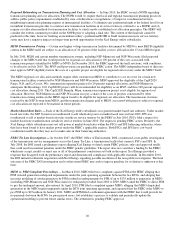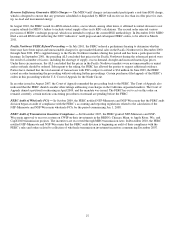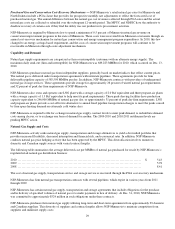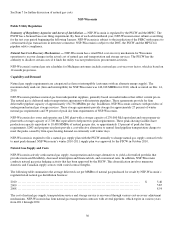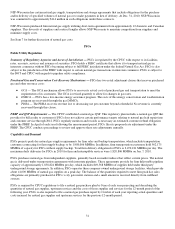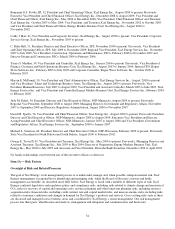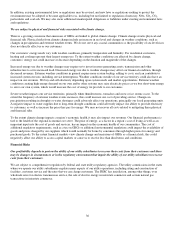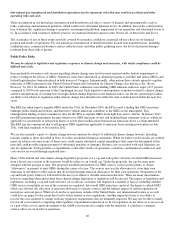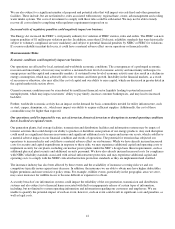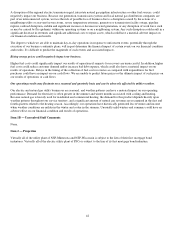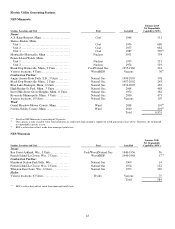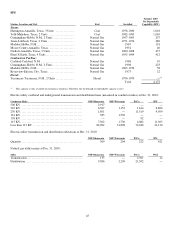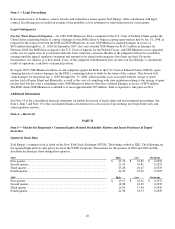Xcel Energy 2010 Annual Report Download - page 46
Download and view the complete annual report
Please find page 46 of the 2010 Xcel Energy annual report below. You can navigate through the pages in the report by either clicking on the pages listed below, or by using the keyword search tool below to find specific information within the annual report.36
In addition, existing environmental laws or regulations may be revised, and new laws or regulations seeking to protect the
environment may be adopted or become applicable to us, including but not limited to regulation of mercury, NOx, SO2, CO2,
particulates and coal ash. We may also incur additional unanticipated obligations or liabilities under existing environmental laws
and regulations.
We are subject to physical and financial risks associated with climate change.
There is a growing consensus that emissions of GHGs are linked to global climate change. Climate change creates physical and
financial risk. Physical risks from climate change include an increase in sea level and changes in weather conditions, such as
changes in precipitation and extreme weather events. We do not serve any coastal communities so the possibility of sea level rises
does not directly affect us or our customers.
Our customers’ energy needs vary with weather conditions, primarily temperature and humidity. For residential customers,
heating and cooling represent their largest energy use. To the extent weather conditions are affected by climate change,
customers’ energy use could increase or decrease depending on the duration and magnitude of the changes.
Increased energy use due to weather changes may require us to invest in more generating assets, transmission and other
infrastructure to serve increased load. Decreased energy use due to weather changes may affect our financial condition, through
decreased revenues. Extreme weather conditions in general require more system backup, adding to costs, and can contribute to
increased system stresses, including service interruptions. Weather conditions outside of our service territory could also have an
impact on our revenues. We buy and sell electricity depending upon system needs and market opportunities. Extreme weather
conditions creating high energy demand on our own and/or other systems may raise electricity prices as we buy short-term energy
to serve our own system, which would increase the cost of energy we provide to our customers.
Severe weather impacts our service territories, primarily when thunderstorms, tornadoes and snow or ice storms occur. To the
extent the frequency of extreme weather events increases, this could increase our cost of providing service. Changes in
precipitation resulting in droughts or water shortages could adversely affect our operations, principally our fossil generating units.
A negative impact to water supplies due to long-term drought conditions could adversely impact our ability to provide electricity
to customers, as well as increase the price they pay for energy. We may not recover all costs related to mitigating these physical
and financial risks.
To the extent climate change impacts a region’s economic health, it may also impact our revenues. Our financial performance is
tied to the health of the regional economies we serve. The price of energy, as a factor in a region’s cost of living as well as an
important input into the cost of goods and services, has an impact on the economic health of our communities. The cost of
additional regulatory requirements, such as a tax on GHGs or additional environmental regulation could impact the availability of
goods and prices charged by our suppliers which would normally be borne by consumers through higher prices for energy and
purchased goods. To the extent financial markets view climate change and emissions of GHGs as a financial risk, this could
negatively affect our ability to access capital markets or cause us to receive less than ideal terms and conditions.
Financial Risks
Our profitability depends in part on the ability of our utility subsidiaries to recover their costs from their customers and there
may be changes in circumstances or in the regulatory environment that impair the ability of our utility subsidiaries to recover
costs from their customers.
We are subject to comprehensive regulation by federal and state utility regulatory agencies. The utility commissions in the states
where we operate our utility subsidiaries regulate many aspects of our utility operations, including siting and construction of
facilities, customer service and the rates that we can charge customers. The FERC has jurisdiction, among other things, over
wholesale rates for electric transmission service, the sale of electric energy in interstate commerce and certain natural gas
transactions in interstate commerce.


